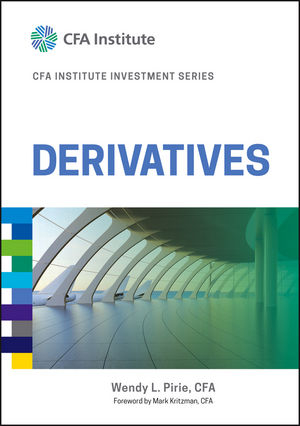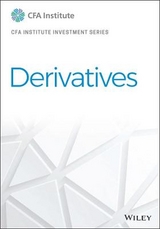
Derivatives
John Wiley & Sons Inc (Verlag)
978-1-119-38181-5 (ISBN)
- Titel erscheint in neuer Auflage
- Artikel merken
The complete guide to derivatives, from the experts at the CFA Derivatives is the definitive guide to derivatives, derivative markets, and the use of options in risk management. Written by the experts at the CFA Institute, this book provides authoritative reference for students and investment professionals seeking a deeper understanding for more comprehensive portfolio management. General discussion of the types of derivatives and their characteristics gives way to detailed examination of each market and its contracts, including forwards, futures, options, and swaps, followed by a look at credit derivatives markets and their instruments. Included lecture slides help bring this book directly into the classroom, while the companion workbook (sold separately) provides problems and solutions that align with the text and allows students to test their understanding while facilitating deeper internalization of the material. Derivatives have become essential to effective financial risk management, and create synthetic exposure to asset classes. This book builds a conceptual framework for understanding derivative fundamentals, with systematic coverage and detailed explanations.
* Understand the different types of derivatives and their characteristics * Delve into the various markets and their associated contracts * Examine the use of derivatives in portfolio management * Learn why derivatives are increasingly fundamental to risk management The CFA Institute is the world's premier association for investment professionals, and the governing body for the CFA, CIPM, and Investment Foundations Programs. Those seeking a deeper understanding of the markets, mechanisms, and use of derivatives will value the level of expertise CFA lends to the discussion, providing a clear, comprehensive resource for students and professionals alike. Whether used alone or in conjunction with the companion workbook, Derivatives offers a complete course in derivatives and their markets.
WENDY L. PIRIE, PD, CFA, is Director, Curriculum Projects, in the Education Division at CFA Institute. She holds a PhD in accounting and finance from Queen's University at Kingston, Ontario, and MBAs from the Universities of Toronto and Calgary. She is a member of CFA Institute, New York Society of Security Analysts, and CFA Society Chicago.
Foreword xi Preface xv Acknowledgments xvii About the CFA Investment Series xix Chapter 1 Derivative Markets and Instruments 1 Learning Outcomes 1 1. Introduction 1 2. Derivatives: Definitions and Uses 2 3. The Structure of Derivative Markets 5 3.1. Exchange-Traded Derivatives Markets 6 3.2. Over-the-Counter Derivatives Markets 8 4. Types of Derivatives 10 4.1. Forward Commitments 10 4.2. Contingent Claims 21 4.3. Hybrids 32 4.4. Derivatives Underlyings 33 5. The Purposes and Benefits of Derivatives 37 5.1. Risk Allocation, Transfer, and Management 38 5.2. Information Discovery 38 5.3. Operational Advantages 39 5.4. Market Efficiency 39 6. Criticisms and Misuses of Derivatives 40 6.1. Speculation and Gambling 40 6.2. Destabilization and Systemic Risk 41 7. Elementary Principles of Derivative Pricing 43 7.1. Storage 44 7.2. Arbitrage 45 8. Summary 50 Problems 51 Chapter 2 Basics of Derivative Pricing and Valuation 55 Learning Outcomes 55 1. Introduction 56 2. Fundamental Concepts of Derivative Pricing 56 2.1. Basic Derivative Concepts 56 2.2. Pricing the Underlying 58 2.3. The Principle of Arbitrage 62 2.4. The Concept of Pricing versus Valuation 68 3. Pricing and Valuation of Forward Commitments 69 3.1. Pricing and Valuation of Forward Contracts 69 3.2. Pricing and Valuation of Futures Contracts 76 3.3. Pricing and Valuation of Swap Contracts 78 4. Pricing and Valuation of Options 81 4.1. European Option Pricing 82 4.2. Binomial Valuation of Options 97 4.3. American Option Pricing 101 5. Summary 104 Problems 106 Chapter 3 Pricing and Valuation of Forward Commitments 111 Learning Outcomes 111 1. Introduction 111 2. Principles of Arbitrage-Free Pricing and Valuation of Forward Commitments 112 3. Pricing and Valuing Forward and Futures Contracts 113 3.1. Our Notation 113 3.2. No-Arbitrage Forward Contracts 115 3.3. Equity Forward and Futures Contracts 126 3.4. Interest Rate Forward and Futures Contracts 129 3.5. Fixed-Income Forward and Futures Contracts 138 3.6. Currency Forward and Futures Contracts 144 3.7. Comparing Forward and Futures Contracts 148 4. Pricing and Valuing Swap Contracts 149 4.1. Interest Rate Swap Contracts 151 4.2. Currency Swap Contracts 156 4.3. Equity Swap Contracts 164 5. Summary 169 Problems 170 Chapter 4 Valuation of Contingent Claims 177 Learning Outcomes 177 1. Introduction 178 2. Principles of a No-Arbitrage Approach to Valuation 178 3. Binomial Option Valuation Model 180 3.1. One-Period Binomial Model 181 3.2. Two-Period Binomial Model 189 3.3. Interest Rate Options 202 3.4. Multiperiod Model 204 4. Black Scholes Merton Option Valuation Model 205 4.1. Introductory material 205 4.2. Assumptions of the BSM model 205 4.3. BSM model 208 5. Black Option Valuation Model 215 5.1. European Options on Futures 215 5.2. Interest Rate Options 217 5.3. Swaptions 221 6. Option Greeks and Implied Volatility 224 6.1. Delta 224 6.2. Gamma 228 6.3. Theta 230 6.4. Vega 231 6.5. Rho 232 6.6. Implied Volatility 233 7. Summary 237 Problems 239 Chapter 5 Derivatives Strategies 245 Learning Outcomes 245 1. Introduction 246 2. Changing Risk Exposures with Swaps, Futures, and Forwards 246 2.1. Interest Rate Swap/Futures Examples 246 2.2. Currency Swap/Futures Examples 248 2.3. Equity Swap/Futures Examples 250 3. Position Equivalencies 252 3.1. Synthetic Long Asset 253 3.2. Synthetic Short Asset 253 3.3. Synthetic Assets with Futures/Forwards 254 3.4. Synthetic Put 254 3.5. Synthetic Call 255 3.6. Foreign Currency Options 255 4. Covered Calls and Protective Puts 257 4.1. Investment Objectives of Covered Calls 258 4.2. Investment Objective of Protective Puts 262 4.3. Equivalence to Long Asset/Short Forward Position 266 4.4. Writing Cash-Secured Puts 266 4.5. The Risk of Covered Calls and Protective Puts 267 4.6. Collars 268 5. Spreads and Combinations 270 5.1. Bull Spreads and Bear Spreads 271 5.2. Calendar Spread 278 5.3. Straddle 279 5.4. Consequences of Exercise 280 6. Investment Objectives and Strategy Selection 281 6.1. The Necessity of Setting an Objective 281 6.2. Spectrum of Market Risk 282 6.3. Analytics of the Breakeven Price 282 6.4. Applications 285 7. Summary 291 Problems 292 Chapter 6 Risk Management 295 Learning Outcomes 295 1. Introduction 296 2. Risk Management as a Process 297 3. Risk Governance 300 4. Identifying Risks 303 4.1. Market Risk 305 4.2. Credit Risk 306 4.3. Liquidity Risk 307 4.4 Operational Risk 308 4.5. Model Risk 309 4.6. Settlement (Herstatt) Risk 309 4.7. Regulatory Risk 310 4.8. Legal/Contract Risk 311 4.9. Tax Risk 311 4.10. Accounting Risk 312 4.11. Sovereign and Political Risks 313 4.12. Other Risks 314 5. Measuring Risk 315 5.1. Measuring Market Risk 315 5.2. Value at Risk 317 5.3. The Advantages and Limitations of VaR 333 5.4. Extensions and Supplements to VaR 335 5.5. Stress Testing 335 5.6. Measuring Credit Risk 337 5.7. Liquidity Risk 345 5.8. Measuring Nonfinancial Risks 345 6. Managing Risk 347 6.1. Managing Market Risk 347 6.2. Managing Credit Risk 351 6.3. Performance Evaluation 354 6.4. Capital Allocation 356 6.5. Psychological and Behavioral Considerations 358 7. Summary 358 Problems 361 Chapter 7 Risk Management Applications of Forward and Futures Strategies 369 Learning Outcomes 369 1. Introduction 370 2. Strategies and Applications for Managing Interest Rate Risk 371 2.1. Managing the Interest Rate Risk of a Loan Using an FRA 371 2.2. Strategies and Applications for Managing Bond Portfolio Risk 375 3. Strategies and Applications for Managing Equity Market Risk 385 3.1. Measuring and Managing the Risk of Equities 385 3.2. Managing the Risk of an Equity Portfolio 387 3.3. Creating Equity out of Cash 390 3.4. Creating Cash out of Equity 395 4. Asset Allocation with Futures 399 4.1. Adjusting the Allocation among Asset Classes 399 4.2. Pre-Investing in an Asset Class 406 5. Strategies and Applications for Managing Foreign Currency Risk 409 5.1. Managing the Risk of a Foreign Currency Receipt 410 5.2. Managing the Risk of a Foreign Currency Payment 411 5.3. Managing the Risk of a Foreign-Market Asset Portfolio 413 6. Futures or Forwards? 417 7. Final Comments 419 8. Summary 420 Problems 422 Chapter 8 Risk Management Applications of Option Strategies 425 Learning Outcomes 425 1. Introduction 426 2. Option Strategies for Equity Portfolios 427 2.1. Standard Long and Short Positions 429 2.2. Risk Management Strategies with Options and the Underlying 437 2.3. Money Spreads 444 2.4. Combinations of Calls and Puts 456 3. Interest Rate Option Strategies 465 3.1. Using Interest Rate Calls with Borrowing 466 3.2. Using Interest Rate Puts with Lending 471 3.3. Using an Interest Rate Cap with a Floating-Rate Loan 477 3.4. Using an Interest Rate Floor with a Floating-Rate Loan 481 3.5. Using an Interest Rate Collar with a Floating-Rate Loan 484 4. Option Portfolio Risk Management Strategies 488 4.1. Delta Hedging an Option over Time 490 4.2. Gamma and the Risk of Delta 498 4.3. Vega and Volatility Risk 499 5. Final Comments 500 6. Summary 501 Problems 503
| Erscheinungsdatum | 28.04.2017 |
|---|---|
| Verlagsort | New York |
| Sprache | englisch |
| Maße | 183 x 272 mm |
| Gewicht | 1262 g |
| Themenwelt | Wirtschaft ► Betriebswirtschaft / Management ► Finanzierung |
| ISBN-10 | 1-119-38181-9 / 1119381819 |
| ISBN-13 | 978-1-119-38181-5 / 9781119381815 |
| Zustand | Neuware |
| Informationen gemäß Produktsicherheitsverordnung (GPSR) | |
| Haben Sie eine Frage zum Produkt? |
aus dem Bereich



